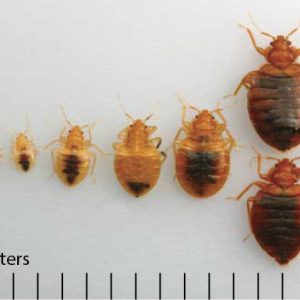
Learn how to keep bed bugs out of your home with these tips from the City of Goleta Environmental Services Division.
Bed bugs are small, flat insects that hide in tight spaces like mattress seams and cracks in furniture. They are similar in color to an apple seed, but a bit smaller. Young bed bugs start off about the size of a poppy seed. They bite us while we are resting or sleeping.
Anyone can get bed bugs. Infestations are becoming more common, and once you have them, they can be hard to control. There are some things you can do yourself, but you may need to use a pest control professional to successfully control bed bugs. If you rent and have bed bugs, you will need to work with your landlord to make sure bugs are eliminated.
Did You Know?
- Bed bugs do not transmit diseases.
- Like mosquitoes, bed bugs feed on human blood. They may occasionally feed on pets and other animals.
- Some people have no reaction to bed bug bites; others can suffer itchy welts.
- Store bought “bug bombs” are ineffective and can push bed bugs into other rooms.
- Don’t throw out infested items! Most can be treated.
- Bed bugs move around by hitching rides on furniture, bedding, baggage, clothing, and other personal belongings.
How Can You Tell If You Have An Infestation?
Getting bug bites doesn’t necessarily mean you have bed bugs; you also need to look for:
- Dark, rusty or reddish spotting or staining on sheets, mattresses, walls, and around small, dark spaces.
- Live bugs, eggs, eggs shells, and shed skins.
What Can You Do?
Some sprays may be effective if you hit the bugs directly, but insecticides alone cannot eliminate a bed bug infestation. Over-the-counter ‘bug bombs’ are not effective and may scatter bed bugs into new rooms in your home or into neighbors’ apartments. Some sprays may be effective if you directly hit the bed bugs.
- Tell your landlord immediately if you see bed bugs. The longer you wait, the harder it will be to control the bugs. In California, landlords must conduct inspections when they are notified of bed bug problems.
- Before you move in, ask if the unit has been inspected for bed bugs. Landlords may not knowingly rent out homes with bed bugs.
- Look for signs of bed bugs and know where they hide. They aren’t just on mattresses. Check bed frames, headboards, along baseboards, under and behind furniture, around electrical sockets, and any other dark hidden areas near beds. Use a bright flashlight.
- Catch bugs with a sticky lint roller or packing tape. Caught bugs can be identified by pest control professionals.
- Vacuum infested areas thoroughly. This can quickly remove many live bugs. Immediately after vacuuming, remove the vacuum bag or canister contents, seal in a plastic bag and dispose of right away. Vacuuming alone will not eliminate an infestation.
- Use the clothes dryer to kill bed bugs. You can kill all stages of bed bugs on dry cloth items by tumble drying them for 15 minutes on “high.” If items are wet, dry them first, and then continue tumbling on “high” for at least an additional 15 minutes. Wash and dry your sheets at least every 2 weeks.
- Consider desiccant dusts. These products kill bugs and their eggs by drying them out. Dusts can irritate your lungs, so they should only be used in wall voids, cracks, and other areas where they won’t be breathed in.
- Protect your mattress and box spring with mattress encasements. These covers seal bugs inside and make bed inspection easier.
- Consider pitfall traps for use under beds and furniture legs. These traps help detect bed bugs and may also help prevent bed bug bites. Be sure to pull beds, sofas and other furniture away from the wall, and keep bedding from touching the floor.
- Remove as much clutter as possible, especially around your sleeping area. Clutter hides bed bugs and makes inspection and control difficult.
Remember, there is no magic formula that will guarantee bed bug elimination. These tips are not intended to replace a treatment program by knowledgeable professionals.

When You Travel
Check your hotel room. Travel with a flashlight and inspect the bed, bed skirt, nearby furnishings, baseboards, drapes, and if you can, behind the headboard and items hanging on the wall. If you find bed bugs or their signs, request to be moved. Inspect the new room, too.
For extra protection:
- Keep your luggage in the bathtub or in a sealed plastic bag. Bed bugs are unlikely to be in the bathroom.
- When you get home, open your luggage outside the house and put the contents into a plastic bag. Carefully inspect luggage with a light and magnifying glass before you bring it inside. Store luggage far from sleeping and resting places.
- Wash and/or dry everything you can.
The City of Goleta along with the Cities of Buellton, Carpinteria, Solvang, Santa Barbara, Santa Maria and the County of Santa Barbara have partnered with the OWOW organization to promote the use of less-toxic products in an effort to reduce pesticide pollution in our communities. By reducing pesticide use and the use of less-toxic products around the home, you can help reduce pesticides and other pollutants such as herbicides and fertilizers from being picked up while watering or when it rains and transported to the nearest storm drain inlet and into our waterways. The OWOW website is user-friendly and a great resource for finding less-toxic products to use around your home or garden.

